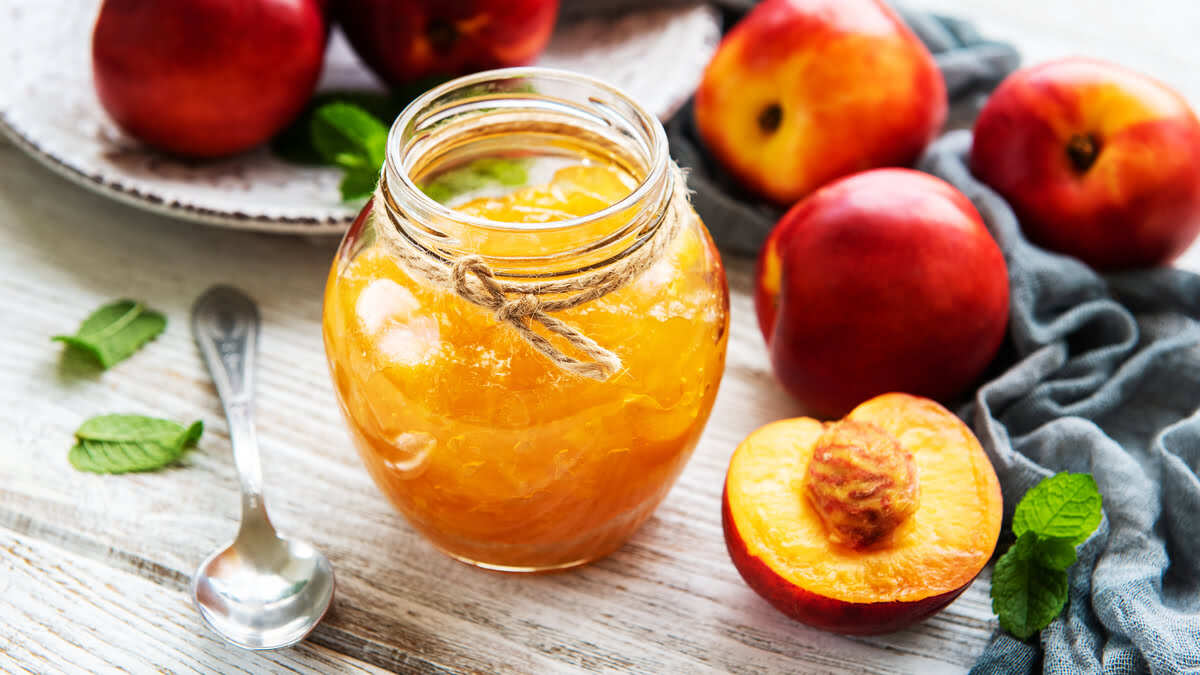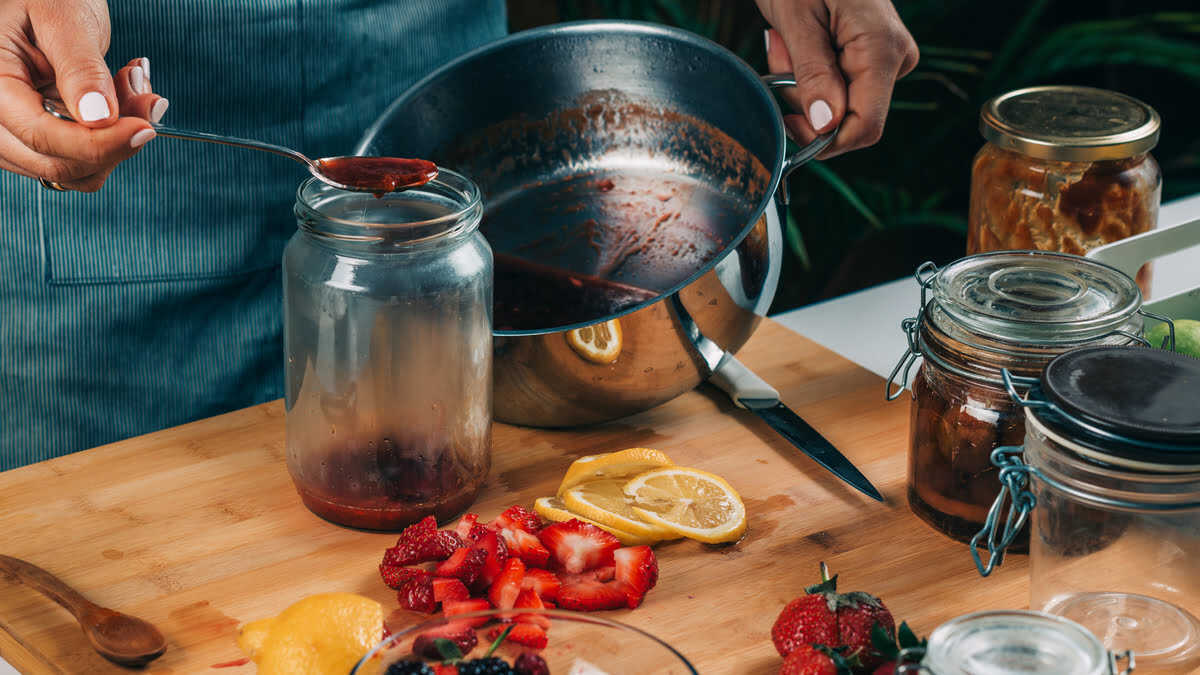Pectin | What is it and how to use it?
Pectin is a natural, plant-derived ingredient that has been used for years in the kitchen and the food industry. Thanks to its gelling properties, it is a popular alternative to gelatin, agar and guar gum. It is eagerly used in the production of jams, jellies, marmalades and other preserves, to which it gives the right structure and consistency.
What exactly is pectin, how does it work, and how can it be used in everyday cooking? In the article below, we explain how to use pectin step by step, how it differs from other thickeners, and which properties have earned it such great popularity.
What is pectin?
Pectin is a natural chemical compound belonging to the group of polysaccharides, found in plants—mainly in their cell walls and intercellular spaces. It plays an important role in maintaining proper hydration of plant tissues and is part of their structure, giving them elasticity and springiness.
The largest amounts of pectin can be found in citrus peels, apples, currants, gooseberries, sugar beets, or the hulls of legume seeds such as soybeans. This substance is classified as a fraction of soluble fiber and is valued for its gelling properties, which are used, among other things, in the production of fruit preserves and desserts.
Although today it is known as “pectin,” in the past in Poland it was called “krzepnik.” The current name comes from Greek—the word pektos means “coagulated” or “set,” which perfectly reflects the characteristic action of this substance.
Types of pectins
Pectins are divided into several basic types that differ in chemical structure and mode of action—and therefore in application. The key factor here is the degree of esterification, i.e., the number of methyl groups attached to pectin molecules.
- High-methoxyl pectin (HM) gels in the presence of sugar and acid. It works perfectly in traditional fruit preserves such as jams or jellies, where the sugar content is relatively high. This is the most common type of pectin found in products on the market.
- Low-methoxyl pectin (LM) does not require a large amount of sugar to achieve a gel-like consistency—calcium ions are sufficient. Therefore, it is used in low-sugar preserves and diet products.
- Amidated pectin (amidated LM) is also available on the market; it shows greater resistance to changes in temperature and pH. Its flexibility makes it popular in modern food formulations.
- A special type is NH pectin, which allows reheating and re-setting without losing gelling properties. It is an ideal solution for glazes, confectionery fillings, and preserves that require heat treatment after setting.
How to use pectin?
Pectin, whether naturally sourced or industrially produced, is a versatile additive used in the kitchen and the food industry. It works excellently as a gelling and thickening agent when preparing homemade jams, confitures, jellies, fruit mousses, or confectionery fillings. It is also used in glazes, icings, and creams, to which it gives the right texture and stability.

The typical amount of pectin used when preparing preserves is 10–20 grams per 1 kilogram of fruit. However, the exact proportion depends on the type of pectin used and the desired thickness of the final product. Some fruits, such as apples or currants, naturally contain more pectin, which may require recipe adjustments.
It is worth noting that pectin has no smell or pronounced taste, so it does not change the character of the dish. Instead, it improves its sensory qualities by providing the right structure and extending freshness. This makes it highly valued not only by home-preserving enthusiasts but also by professionals in the confectionery and gastronomy industries.
How to dissolve pectin?
The method of dissolving pectin depends primarily on its form and type. Products are available in powder, liquid, and ready-made blends with added sugar.
Most often, powdered pectin is mixed with sugar to prevent clumping and ensure even distribution throughout the fruit mass. In some cases, it is necessary to dissolve it first in a small amount of water—cold or warm—depending on the manufacturer’s recommendations.
Some pectins require heating and even bringing the mixture to a boil to activate their gelling properties. Others work at lower temperatures, which means they can be used in more delicate recipes without the risk of losing fruit aroma or compromising product structure.
A major advantage of pectin is its resistance to high temperatures and to low storage temperatures—it performs excellently both in baked goods and in desserts intended for freezing. Thanks to this, it can be successfully used in a wide range of products that require a durable, elastic consistency.
Is pectin vegan?
Yes, pectin is a plant-based ingredient, which means it can be safely consumed by people on vegan and vegetarian diets. Unlike gelatin, which is derived from animal tissues, pectin is obtained from fruits—most often apples, citrus fruits, or the peels of other plants.
One important advantage of pectin is that it does not affect the taste or smell of dishes, which makes it an exceptionally neutral additive. Its versatility means it is eagerly chosen by confectioners and food manufacturers who want to reach a broad audience—regardless of lifestyle or dietary beliefs. Thanks to pectin, it is possible to prepare desserts, confitures, and jellies that are not only tasty but also fully plant-based. Today, pectin is one of the most commonly chosen gelatin substitutes, alongside agar.
Is pectin healthy?
Pectin is considered a safe substance that is well tolerated by the human body. Consumed in reasonable amounts, it does not cause side effects, although in excess—like any fiber component—it may cause temporary intestinal discomfort such as bloating or loose stools. Nevertheless, due to its beneficial physiological effects, pectin is classified as functional food that supports the proper functioning of the digestive system.
As a fraction of water-soluble fiber, pectin performs a number of health-promoting functions. After consumption, it binds water and increases in volume in the digestive tract, which prolongs the feeling of fullness, regulates appetite, and facilitates bowel movements—features valued in weight-reduction diets. Additionally, it has a prebiotic effect, supporting the growth of beneficial intestinal bacteria. Pectin slows the absorption of glucose from the small intestine, which helps maintain stable blood sugar levels. Its ability to bind bile acids translates into lower cholesterol levels. Moreover, pectin helps remove heavy metals from the body, such as lead or mercury, supporting detoxification.
How does pectin affect the human body?
Pectin, as a fraction of soluble fiber, exerts a range of beneficial physiological effects on the human body. After consumption, it remains resistant to digestive enzymes in the stomach and small intestine, so it reaches the colon in an almost unchanged form. Only there, under the influence of enzymes produced by the gut microbiota, does it undergo partial fermentation, producing short-chain fatty acids, including butyric, propionic, and acetic acids.
These acids perform various biological functions:
- Butyric acid is the primary source of energy for colon cells,
- Propionic acid may limit cholesterol production in the liver,
- and acetic acid exhibits antibacterial activity.
Additionally, these substances support the absorption of water and electrolytes, alleviating diarrhea, while at the same time stimulating peristalsis, which also makes pectin effective in combating constipation.
How much does pectin cost?
The price of pectin depends primarily on its type, form, and place of purchase. Natural pectin can be found in health food stores—both brick-and-mortar and online. Its cost is usually a dozen or so zlotys per 100 grams, and such an amount is enough to prepare several batches of preserves. Typically, for 1 kilogram of fruit, 10 to 20 grams of pectin are used, which makes this ingredient relatively efficient.
In popular supermarkets and grocery stores, there are also ready-made gelling sugars, which are blends of pectin, sugar, and acidity regulators and preservatives. Their price is usually a few zlotys per portion, sufficient to process 1 kg of fruit. Although the price difference between pure pectin and a ready-made blend is not large, the differences in composition can be significant—especially for people avoiding additives such as sodium benzoate or sorbic acid.
Regardless of the choice, both pure pectin and ready-made blends allow for quick and easy preparation of homemade preserves. Most manufacturers include precise instructions on the packaging regarding proportions and methods of use, which further simplifies the entire process.
Homemade pectin
For those seeking natural and eco-friendly solutions, preparing pectin at home is an excellent alternative to ready-made store products. This approach not only allows you to use fruit remnants but also gives you full control over the composition of the preparation—without unnecessary additives or preservatives.
Apple leftovers are best for home production, such as peels, cores, or residues from juicing. For every kilogram of such raw material, about 175 ml of water is sufficient. Cook everything over low heat, covered, for 20–25 minutes—without bringing it to a vigorous boil. After cooking, set the mixture aside to cool, then pour it through a fine sieve or cheesecloth, leaving it for several hours—preferably overnight—so the liquid can separate freely from the solids.
The resulting liquid is natural pectin, ready to use in jams, jellies, or fruit mousses. It can also be heated and poured into sterilized jars, then pasteurized, allowing for longer storage. Such a homemade extract is not only a healthy and economical alternative to ready-made thickeners but also a way to reduce food waste.
Alternatives to pectin
Although pectin is very popular as a natural gelling agent, it is not the only substance with such properties. There are many alternatives that can serve a similar function in the kitchen and food industry—both plant- and animal-based.
One of the most commonly used substitutes is, of course, gelatin, a collagen protein obtained from animal products. It sets at low temperatures and gives desserts a delicate, springy texture. However, it is not suitable for vegans and vegetarians, which is why plant-based alternatives are increasingly popular.
Among them, agar, obtained from red seaweeds, is worth mentioning. It gels at room temperature and does not require added sugar, making it ideal for many diet recipes. Another option is starch—for example, corn or potato—widely used as a thickener in sauces, puddings, or kissels.
Depending on the type of dish, the desired end result, and dietary preferences, each of these substances can replace pectin—however, it is worth remembering that they differ in their mode of action, taste, and the texture of the finished product.
Pectin | Summary
Pectin is a versatile, natural ingredient that plays an important role not only in the kitchen but also in maintaining a healthy diet. Thanks to its gelling and stabilizing properties, it is used in preparing homemade preserves, desserts, and many food products. Its plant origin makes it an excellent choice for those following a vegan diet, and its numerous health benefits—from supporting digestion to regulating cholesterol levels—mean it is also appreciated by advocates of functional foods.
Whether you choose a ready-made product or prepare homemade pectin, it is worth having this ingredient in your pantry. It is a natural way to give dishes the right consistency while supporting health and reducing the amount of artificial additives in our diet.


